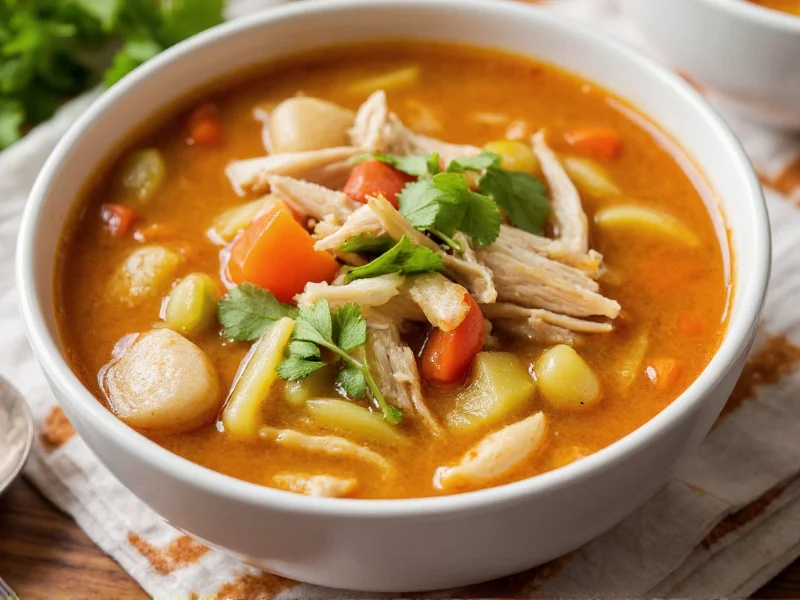Homemade chicken vegetable soup represents culinary simplicity at its finest—a nourishing combination of lean protein and garden-fresh produce simmered to perfection. Unlike canned alternatives loaded with sodium and preservatives, preparing this classic dish from scratch allows complete control over ingredients and flavor development. The magic happens when collagen-rich chicken bones release gelatin during slow simmering, creating that signature velvety texture while delivering joint-supporting nutrients.
Why Homemade Soup Outperforms Store-Bought Versions
Commercial soups often contain 800-1000mg of sodium per serving—nearly half your daily recommended limit. By making your own easy chicken vegetable soup recipe, you eliminate unnecessary additives while maximizing nutritional density. The natural glutamine from chicken bones supports gut health, while the vitamin C from fresh vegetables enhances iron absorption from the meat.
Essential Ingredients for Flavorful Results
Quality ingredients form the foundation of exceptional soup. Select these components carefully:
| Ingredient Category | Recommended Choices | Avoid |
|---|---|---|
| Protein Base | Chicken bones with meat, rotisserie chicken carcass, or bone-in thighs | Pre-cooked shredded chicken (lacks depth)|
| Aromatic Vegetables | Fresh onions, celery, carrots (the "holy trinity" of soup making) | Canned or frozen alternatives|
| Flavor Enhancers | Fresh garlic, thyme sprigs, bay leaves, parsley stems | Excessive salt or MSG|
| Vegetable Additions | Zucchini, green beans, peas, kale (added late in cooking) | Overcooked canned vegetables
Step-by-Step Preparation Guide
Follow this professional technique for homemade chicken vegetable soup from scratch that develops complex flavors:
- Build the foundation: Sauté onions, carrots, and celery in olive oil until translucent (8-10 minutes)
- Develop depth: Add chicken bones and sear lightly to enhance Maillard reaction flavors
- Create broth: Cover with 8 cups cold water, add herbs, and simmer uncovered for 45 minutes
- Strain and refine: Remove bones, skim excess fat, and return clear broth to pot
- Add vegetables: Incorporate diced vegetables and cook until tender-crisp (15-20 minutes)
- Finish with protein: Add shredded chicken during last 5 minutes to prevent overcooking
Avoiding Common Preparation Mistakes
Even experienced cooks make these critical errors when preparing healthy chicken vegetable soup:
- Boiling instead of simmering: Vigorous boiling makes chicken tough and clouds the broth
- Adding vegetables too early: Delicate produce turns mushy when cooked longer than necessary
- Over-salting at the start: Season gradually as liquid reduces during cooking
- Skipping the skimming step: Removing foam during initial simmering ensures crystal-clear broth
Nutritional Powerhouse Benefits
This chicken vegetable soup nutritional benefits extend far beyond comfort food status. A single serving provides:
- 25g high-quality protein for muscle maintenance
- 100% daily vitamin A from carrots for eye health
- Significant vitamin C from fresh vegetables
- Natural electrolytes for hydration support
- Gelatin for joint and gut health from bone broth
The combination of lean protein and fiber-rich vegetables creates a satiating meal with approximately 250 calories per serving—making it ideal for chicken vegetable soup for meal prep throughout the week.
Variations for Dietary Needs
Adapt this versatile recipe for specific requirements without sacrificing flavor:
- Gluten-free version: Use tamari instead of soy sauce and ensure broth is certified GF
- Keto adaptation: Increase healthy fats with avocado oil and reduce starchy vegetables
- Vegan alternative: Substitute mushroom broth and add white beans for protein
- Creamy texture without dairy: Blend cooked cauliflower into the broth for richness
Proper Storage and Reheating Techniques
Maximize freshness with these chicken vegetable soup storage tips:
- Cool completely before refrigerating (within 2 hours of cooking)
- Store in airtight containers for up to 4 days
- Freeze in portion-sized containers for up to 3 months
- Reheat gently on stove—avoid microwave which makes vegetables rubbery
- Add fresh herbs after reheating to revive flavor
When properly stored, the flavors actually improve overnight as ingredients meld. This makes chicken vegetable soup for meal prep exceptionally convenient for busy schedules while maintaining nutritional integrity.
Frequently Asked Questions
How long should chicken vegetable soup simmer for optimal flavor?
The ideal simmering time for best chicken vegetable soup cooking time is 45-60 minutes total. Bone-in chicken requires 30 minutes to extract maximum flavor before adding vegetables. After straining the broth, add fresh vegetables and simmer only 15-20 minutes until tender-crisp to preserve nutrients and texture.
Can I make chicken vegetable soup without chicken bones?
Yes, you can create excellent chicken vegetable soup without bones by using high-quality store-bought bone broth or adding 2 tablespoons of nutritional yeast to enhance umami flavor. For protein, include 1.5 cups shredded rotisserie chicken during the last 5 minutes of cooking to prevent toughness.
What vegetables hold up best during reheating?
For optimal texture in chicken vegetable soup storage and reheating, add heartier vegetables like carrots, celery, and green beans initially. Delicate vegetables such as zucchini, spinach, and peas should be added fresh when reheating. This technique prevents mushiness and maintains vibrant color throughout multiple servings.
How can I thicken chicken vegetable soup naturally?
To achieve creamy chicken vegetable soup without cream, try these natural thickening methods: blend 1 cup of cooked cauliflower into the broth, mash some potatoes directly in the pot, or create a cornstarch slurry using 1 tablespoon cornstarch mixed with 2 tablespoons cold water. These techniques add body while maintaining the soup's clean ingredient profile.
Is chicken vegetable soup suitable for weight loss diets?
Absolutely—properly prepared healthy chicken vegetable soup contains approximately 250 calories per 1.5 cup serving with 25g protein and 8g fiber. The high water content and fiber promote satiety while providing essential nutrients. For weight management, focus on vegetable variety while limiting starchy additions like potatoes, and avoid adding unnecessary fats during preparation.











 浙公网安备
33010002000092号
浙公网安备
33010002000092号 浙B2-20120091-4
浙B2-20120091-4